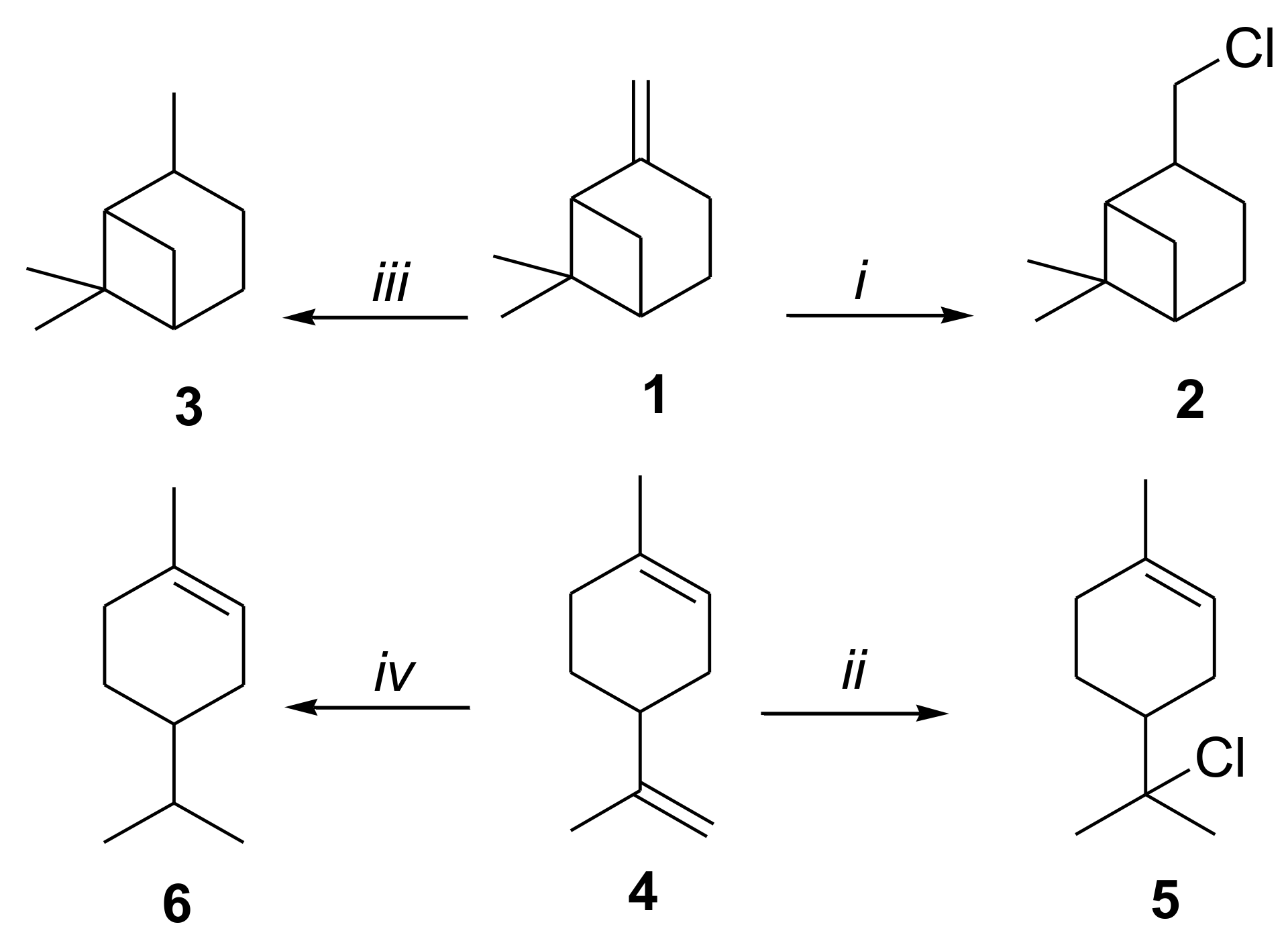Chloropinane and Chloromenthene as Novel Solvents for Solubilisation of Natural Substances
Abstract
1. Introduction
2. Results and Discussion
2.1. Synthesis
2.2. Prediction of Solubilization with COSMO-RS
2.3. Solubility of β-Carotene, Vanillin, Rosmarinic Acid
2.4. Energy Efficiency
3. Materials and Methods
3.1. Chemistry
3.1.1. Synthesis of Chloropinane (2)
3.1.2. Synthesis of Chloromenthene (5)
3.2. Prediction of Solubility
3.3. Test of Solubility
4. Conclusions
Supplementary Materials
Author Contributions
Funding
Institutional Review Board Statement
Informed Consent Statement
Data Availability Statement
Acknowledgments
Conflicts of Interest
References
- Tobiszewski, M.; Tsakovski, S.; Simeonov, V.; Namieśnik, J.; Pena-Pereira, F. A solvent selection guide based on chemometrics and multicriteria decision analysis. Green Chem. 2015, 17, 4773–4785. [Google Scholar] [CrossRef]
- Prat, D.; Hayler, J.; Wells, A. A survey of solvent selection guides. Green Chem. 2014, 16, 4546–4551. [Google Scholar] [CrossRef]
- Varón, E.Y.; Selka, A.; Fabiano-Tixier, A.S.; Balcells, M.; Canela-Garayoa, R.; Bily, A.; Touaibia, M.; Chemat, F. Solvent from forestry biomass. Pinane a stable terpene derived from pine tree byproducts to substitute n-hexane for the extraction of bioactive compounds. Green Chem. 2016, 18, 6596–6608. [Google Scholar] [CrossRef]
- Selka, A.; Levesque, N.A.; Foucher, D.; Clarisse, O.; Chemat, F.; Touaibia, M. A Comparative Study of Solvent-Free and Highly Efficient Pinene Hydrogenation over Pd on Carbon, Alumina, and Silica Supports. Org. Process. Res. Dev. 2017, 21, 60–64. [Google Scholar] [CrossRef]
- Moutombi, F.J.N.; Selka, A.; Fabiano-Tixier, A.-S.; Foucher, D.; Clarisse, O.; Chemat, F.; Touaibia, M. Highly selective solvent-free hydrogenation of pinenes to added-value cis-pinane. Comptes Rendus Chim. 2018, 21, 1035–1042. [Google Scholar] [CrossRef]
- Klamt, A. Prediction of the mutual solubilities of hydrocarbons and water with COSMO-RS. Fluid Phase Equilibria 2003, 206, 223–235. [Google Scholar] [CrossRef]
- Moutombi, F.J.N.; Fabiano-Tixier, A.-S.; Clarisse, O.; Chemat, F.; Touaibia, M. Partial and Total Solvent-Free Limonene’s Hydrogenation: Metals, Supports, Pressure, and Water Effects. J. Chem. 2020, 2020, 5946345. [Google Scholar] [CrossRef]
- Beckmann, J.; Duthie, A.; Grassmann, M. Synthesis and structure of some cis-and trans-myrtanylstannanes. J. Organomet. Chem. 2009, 694, 161–166. [Google Scholar] [CrossRef]
- De Mattos, M.C.S.; Sanseverino, A.M. A Convenient and Simplified Preparation of Both Enantiomers of?-Terpinyl Chloride. Synth. Commun. 2000, 30, 1975–1983. [Google Scholar] [CrossRef]
- Arvayo-Enríquez, H.; Mondaca-Fernández, I.; Gortárez-Moroyoqui, P.; López-Cervantes, J.; Rodríguez-Ramírez, R. Carotenoids extraction and quantification: A review. Anal. Methods 2013, 5, 2916–2924. [Google Scholar] [CrossRef]
- Anastas, P.; Eghbali, N. Green Chemistry: Principles and Practice. Chem. Soc. Rev. 2009, 39, 301–312. [Google Scholar] [CrossRef] [PubMed]
- Sicaire, A.-G.; Vian, M.; Fine, F.; Joffre, F.; Carré, P.; Tostain, S.; Chemat, F. Alternative Bio-Based Solvents for Extraction of Fat and Oils: Solubility Prediction, Global Yield, Extraction Kinetics, Chemical Composition and Cost of Manufacturing. Int. J. Mol. Sci. 2015, 16, 8430–8453. [Google Scholar] [CrossRef] [PubMed]

| Solvent | β-Carotene (g/L) | Vanillin (g/L) | Rosmarinic Acid (g/L) |
|---|---|---|---|
| Chloropinane (2) | 0.53687 | 0.008651508 | 5.08677 × 10−9 |
| Cis-pinane (3) | 0.892240611 | 0.003535516 | 2.8593 × 10−10 |
| Chloromenthene (5) | 0.53687 | 0.012689957 | 2.11912 × 10−8 |
| Menthene (6) | 0.53687 | 0.00429 | 6.9545 × 10−7 |
| n-Hexane | 0.916261686 | 0.002447161 | 5.14395 × 10−11 |
| Solvent | β-Caroten (g/L) | Vanillin (g/L) | Rosmarinic Acid (g/L) |
|---|---|---|---|
| Chloropinane (2) | 6.3 ± 0.14 | 23.85 ± 0.62 | 1.89 ± 0.07 |
| Cis-pinane (3) | 42.7 ± 2.5 | 2.5 ± 0.03 | 0.185 ± 0.003 |
| Chloromenthene (5) | 15.68 ± 0.26 | 0.43 ± 0.02 | 1.09 ± 0.04 |
| Menthene (6) | 3.55 ± 0.10 | 6.07 ± 0.25 | 2.11 ± 0.18 |
| n-Hexane | 0.99 ± 0.06 | 1.19 ± 0.09 | 0.54 ± 0.01 |
| Energy Efficiency a | Chloropinane (2) | Pinane (3) | Chloromenthene (5) | Menthene (6) | Hexane |
|---|---|---|---|---|---|
| ∂Hvap. (kJ/mol) at boiling point | 42.9 | 37.7 | 43.2 | 39.5 | 28.9 |
| E of vaporization (Evap) (kJ/kg) | 248 | 273 | 250 | 286 | 343 |
| Evap compared to hexane (%) | −28 | −20 | −27 | −17 | --- |
Publisher’s Note: MDPI stays neutral with regard to jurisdictional claims in published maps and institutional affiliations. |
© 2021 by the authors. Licensee MDPI, Basel, Switzerland. This article is an open access article distributed under the terms and conditions of the Creative Commons Attribution (CC BY) license (https://creativecommons.org/licenses/by/4.0/).
Share and Cite
Touaibia, M.; Fabiano-Tixier, A.-S.; Chemat, F. Chloropinane and Chloromenthene as Novel Solvents for Solubilisation of Natural Substances. Molbank 2021, 2021, M1205. https://doi.org/10.3390/M1205
Touaibia M, Fabiano-Tixier A-S, Chemat F. Chloropinane and Chloromenthene as Novel Solvents for Solubilisation of Natural Substances. Molbank. 2021; 2021(2):M1205. https://doi.org/10.3390/M1205
Chicago/Turabian StyleTouaibia, Mohamed, Anne-Sylvie Fabiano-Tixier, and Farid Chemat. 2021. "Chloropinane and Chloromenthene as Novel Solvents for Solubilisation of Natural Substances" Molbank 2021, no. 2: M1205. https://doi.org/10.3390/M1205
APA StyleTouaibia, M., Fabiano-Tixier, A.-S., & Chemat, F. (2021). Chloropinane and Chloromenthene as Novel Solvents for Solubilisation of Natural Substances. Molbank, 2021(2), M1205. https://doi.org/10.3390/M1205








